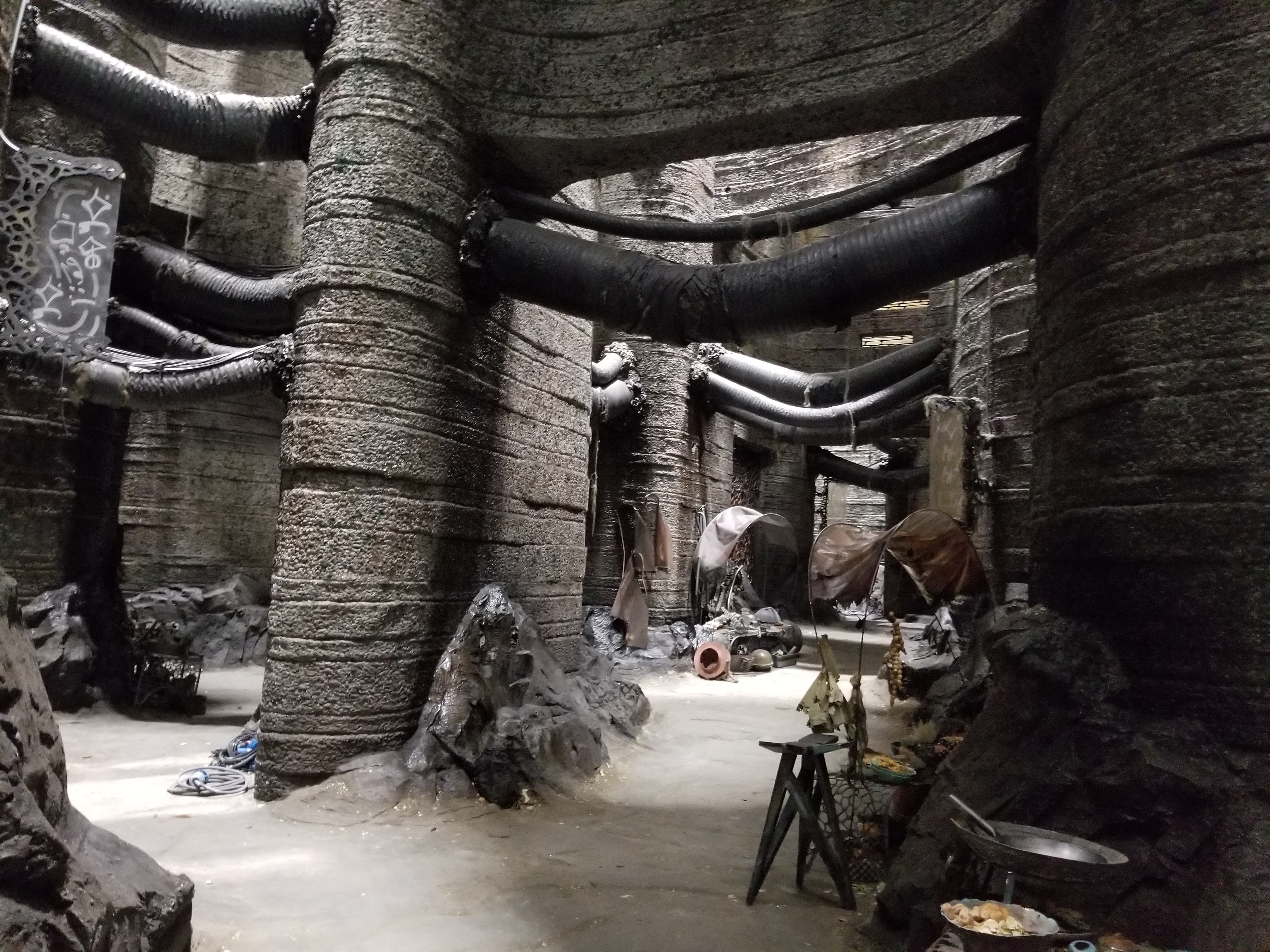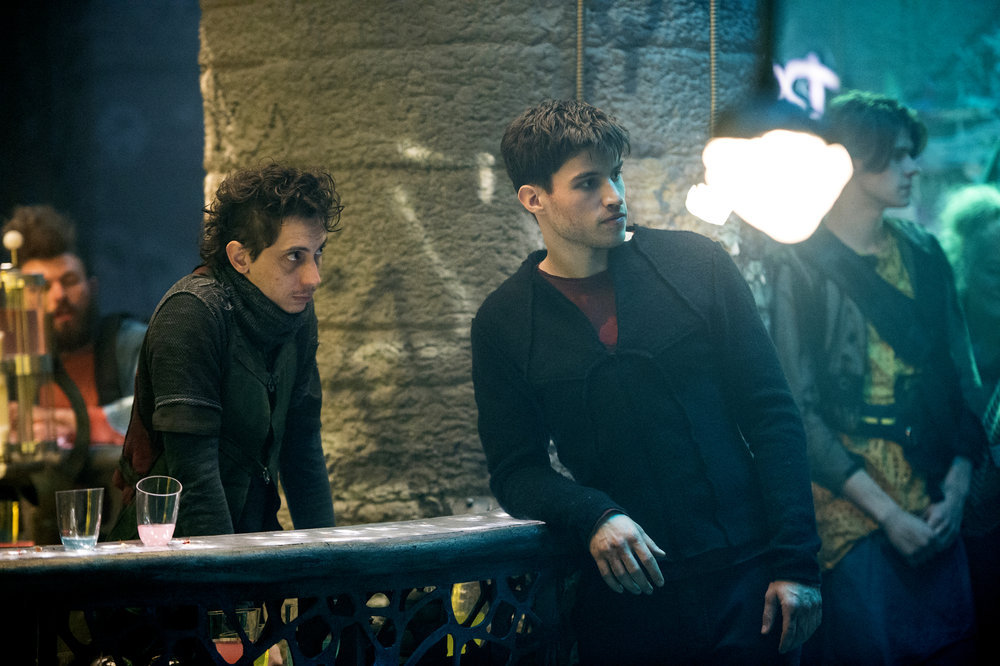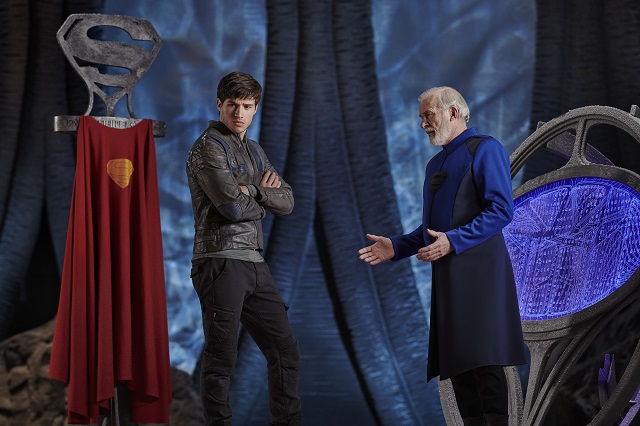Krypton: Bringing Superman’s Home Planet to Life
Syfy's Krypton is more than just a Superman prequel, it's a science fiction show with its own set of rules.
Since it was first announced, Syfy’s upcoming series Krypton has had an uphill climb. The latest in a line of place-specific, high-concept superhero prequels like Smallville or Gotham, Krypton is perhaps the hardest sell. While Smallville was the story of a pre-Superman Clark Kent with “no tights, no flights,” and Gotham is simply the story of the city and its colorful cops and robbers in the days before Bruce Wayne put on a pair of pointy ears, Krypton takes a starkly different approach by going 200 years into the past to tell the story of Superman’s grandfather.
But visiting the sets of Krypton, and listening to the cast and executive producer Cameron Welsh expound on the quest to make the world of Krypton live—and not just as a DC Universe show, but as a piece of science fiction that could stand on its own—convinced me that this show could work. Think of Krypton less as a Superman prequel and more of a science fiction TV show that gives audiences the opportunity to discover a strange and alien world. And make no mistake, the series is exploring elements of Kryptonian society in more detail than we’ve ever seen on screen or page.
Welsh is acutely aware of the pressure on his series, and the need for it to tell its own compelling story. “Maybe I’m biased but I think there’s plenty of interest in the world of Krypton without Superman,” he says. “We haven’t really seen much of this world before, and it’s just this open book [that] allows us to tell a story that hasn’t been told.”
***
Even after 40 years, the dominant impression of Krypton in pop culture is the icy sterility of Richard Donner’s Superman: The Movie. To be sure, there are some echoes of that (and, for that matter, 2013’s Man of Steel as well as other comics and cartoons) in TV’s Krypton. But this isn’t a pristine, frozen, or sterile world. It’s dirty, lived in, imperfect, and politically complex.
”We’re just peeling back a lot more layers than what we’ve seen before,” Welsh says. “Part of what is exciting about doing this is that we get to get really specific and really detailed and really into this world.”

And they certainly do. To the smallest detail, the planet Krypton lives on its soundstages in Belfast, Northern Ireland. The streets of the show’s key city, Kandor, have alleys and market squares for characters (and journalists) to wander through, all designed with an attention to detail that demonstrates a real love of sci-fi and fantasy. Whether it’s the remnants of posters torn and hanging in a bar (a source of debate, as Welsh points out, since “we don’t use paper anywhere else in the show”), the Kryptonian graffiti on the walls (“I trust the art department haven’t written anything offensive,” he jokes), the weird rodent/insect hybrids (“full of protein”) cooked over blue crystals (“you’ll see steam and smoke, but instead of naked flame, they use these blue crystals”) in the street market, or Kryptonian lettering that spells out “take two drops a day, seven days a week” on vials of medicine, Krypton feels more concerned with building its world than blowing it up.
Kryptonian citizens are divided into different guilds. There are guilds for technicians, lawmakers, scientists, the military, artisans, scientists, and clergy. The lower classes are known as the “rankless.” They belong to no guild and live in relative squalor in the literal underside of Kandor. The rankless denizens prowl crowded and darkened streets, forever in the shadow of Kandor’s skyscrapers. As your social status increases, the higher you literally rise in Kandor. The lawmakers and clergy occupy living quarters that are closer to the light of Krypton’s sun god, Rao.
These lower streets of Kandor are known as the “rankless” district, indicative of one of the key sources of conflict on the show: a class struggle that is reflected in virtually every element of Krypton’s design. A recurring feature is a porous, mesh-like metal that makes up everything from chairs and tables to bars and dividing walls. This is apparently the cheapest, most durable material available, and it’s far more common in the rankless areas than it is in the upper echelons of society.
Appropriately, even up above, it never really seems to be midday on Krypton. There’s always the muted warmth of late afternoon, indicative of the diminished light of a giant red sun. But it’s down in that rankless district that we first meet Seg-El, Superman’s grandfather, an angry young man paying for his grandfather’s “crime,” his rank and family station stripped away by Krypton’s ruling class.

Seg-El is played by Cameron Cuffe, and they couldn’t have found a more appropriate or enthusiastic actor for the part. Whenever someone is cast for a superhero or comic book adjacent role, they’re always quick to pay lip service to the source material, the expectations of fans, and the responsibilities that come with the role. But Cuffe is more than a casual fan; he’s fluent in DC Comics mythology in general and Superman in particular (unsurprisingly, he cites the influential Superman work of Geoff Johns and Gary Frank among his favorites, along with Mark Waid and Alex Ross’ Kingdom Come), and it’s clear that he’s utterly sincere about the importance of playing Seg-El.
“The interesting thing about Seg as a hero is that he’s not fully formed,” Cuffe says. “He doesn’t always know right from wrong. The only thing he really has in his life are people he loves. And so when he is finally motivated to come out of that shell, and to prove that he has to be a hero, it’s a role that he doesn’t really know he can fill. He doesn’t think he’s the guy. But he does it anyway, and that ultimately is what being a hero is.”
While fans know that Seg-El’s eventual son, Jor-El, becomes one of the most revered scientists in Kryptonian history, when we meet Seg, there’s little to indicate the family destiny is anything so lofty. “One of Superman’s greatest powers is that he knows right from wrong, and Seg doesn’t,” Cuffe says. “He doesn’t know the way forward. Most of the time he has no idea what he’s doing. He’s just buckling down and holding onto it, and believing in whatever he can believe in, in that moment. And he waivers. He questions himself all the time. But ultimately he stays the course.”
Welsh, on the other hand, sees Seg-El as a potential revolutionary, someone who could “usher in a new golden age” for Krypton. “Part of what we explore in the show is what makes these people special,” Welsh says. “And a lot of that is the House of El and the legacy of the House of El. And when we start our show, we see that Seg is kind of detached from that, having been sort of cast out into the rankless. He’s disconnected from his past and from his legacy and that’s a bit of a journey for him to discover: What that legacy is, what it means to be an El, what the Els have always stood for, and what he’ll learn.”
Seg-El’s resentment of Krypton’s upper class comes with good reason. The House of El is a victim of irrational laws imposed by Kandor’s rulers. Kandor is a theocracy, something incongruous with broader Superman mythology, which has always portrayed Krypton as a planet dominated by science and reason. But here, Kandor’s head of state, who serves above all members of the Lawmaker’s Guild, is the Voice of Rao. The Voice is an eerie, robed figure wearing a multi-faced gold mask which represents Rao’s victory over Krypton’s previous, polytheistic gods and goddesses.
“I think, in the world that we live in, when we look at the roles of religion in society, these can be kind of hot issues that can sort of divide people in a lot of ways,” Welsh says. “We’re sensitive to that, but we sort of want to look at those things. That’s part of the role of science fiction, to help hold up a bit of a mirror to contemporary society but also be entertaining at the same time. It’s like, you don’t wanna know that you’re eating your vegetables.”
Thanks to theocratic rule, this technologically advanced society has not only shut down its space program, but interstellar exploration is banned by Kryptonian law. We all know how that turns out for them 200 years later. “This is a world where… nobody believes in the existence of aliens,” Welsh says. “In this theocracy, the Voice of Rao has basically stated that the god Rao created all life, and Krypton is the totality of his creation… there is nothing else beyond it. So to speak of life outside of Krypton is heresy.”
Symbolically, the “Watchtower,” an enormous platform protruding from one of the tallest structures in Kandor (the Lawmaker’s Guild’s “tower of justice”), was once a space docking station. Now it is used to execute those who dare suggest that Kryptonians can or should explore the stars. One of those heretics is Val-El (played by Game of Thrones’ Ser Barristan Selmy himself, Ian McElhinney), Superman’s great-great grandfather, who is sent to his doom at the edge of the Watchtower in the opening moments of the first episode for defying the will of Rao, bringing about the downfall of the House of El.
That Watchtower is one of Krypton’s nearly full scale sets, and while it isn’t located hundreds of feet in the air, it’s still an enormous, almost intimidating piece of work, even surrounded by green screens, the ultimate signifier of TV and movie magic. You could park a spaceship there, although during my visit, a nearly life-sized “skimmer” (a Kryptonian high speed aircraft) was nearby, likely to make use of the aforementioned green screens.
But in fantasy and science fiction, you’re only as good as the little details, and Raoism, with all the attendant religious trappings therein, has been carefully considered, right down to its holidays. “One of the things we’ll see is what we call the Nova Cycle celebration,” Welsh says. “The Nova Cycle is all about rebirth and it’s almost like a festival of light or something, and it kind of goes on for weeks and weeks. There are different stages to it and different ceremonies involved, and people were asked to give offerings and things like that at different stages. Prisoners are always pardoned by Rao’s grace, things like that.”
Of course nothing could challenge Rao’s central philosophy more than actual alien contact, and that’s exactly what happens when an Earthman named Adam Strange (played by Shaun Sipos) shows up to inform Seg-El that he’s traveled through space and time to deliver a warning: A far more dangerous alien is also approaching, and it’s called “Brainiac.” Brainiac is a powerful artificial intelligence/cybernetic organism who roams the stars collecting data on civilizations… before destroying them. His preferred method of collection is to remove an entire city from the surface of a world, shrink it, “bottle” it, and store it and its collected knowledge in his ship.
Blake Ritson, who plays Brainiac, certainly did his homework. In the course of a conversation with reporters, he namechecks Koko, the space monkey from Brainiac’s earliest comic book adventures; the character’s unfortunate early “pink spandex” costume; and quotes chapter-and-verse dialogue from Geoff Johns and Gary Frank’s excellent Brainiac story from 2007. Ritson has given Brainiac considerable thought and promises that there’s no “mustache-twirling” in his version of the character.
“I’ve played a number of villains over the years,” he says. “Generally, in life, you consider yourself to be the hero of your own narrative. I think you need to find a way into the perspective of a character, where what they’re doing is essentially noble at some level.”
How noble can he be if he plans to destroy an entire planet in order to prevent the existence of our world’s greatest hero?

While still 200 years from its final cataclysm, there are indicators that Krypton is already dying. Some kind of cataclysm took place in the even more distant past, which has rendered vast swaths of the planet frozen, virtually uninhabitable wastelands. Krypton’s nine city-states, of which Kandor is one, live under domes that protect them from the elements. The outer regions, known as the Outlands, are labyrinthine sets covered in “snow” and the remains of unrecognizable (but somewhat familiar) beasts. But it’s in these frozen outlands that another familiar piece of the Superman legend lives: this show’s version of the Fortress of Solitude.
This Fortress was Val-El’s hidden refuge, where he could conduct his illegal scientific experimentations about the nature of the universe, undisturbed by Kryptonian theocrats. That’s a fun twist on the Fortress concept, and seeing the set itself was breathtaking for this Superman fan.
The Fortress is a full-scale set, semi-circular, with a 40-foot ceiling dominated by two 30-foot tall statues representing the first of the line of the House of El. The Fortress’ open, uncluttered design, bathed in blue-ish light, is both a contrast with the claustrophobic feel of the rankless district and a choice that helps it feel even bigger than it already is. The set may appear somewhat minimalist in its decor at first, but a closer look reveals little details from cosmic DC lore scattered throughout, including a Black Mercy from Alan Moore and Dave Gibbons’ classic Superman story, “For the Man Who Has Everything.” The enormous, nearly floor-to-ceiling oval windows, when illuminated, are decorated in Kryptonian lettering. If you can translate Kryptonese, each window tells the story of a different member of the House of El throughout history, like a Kryptonian Stations of the Cross.
“[Seg] will learn that the Els have, for many, many generations, been woven into the fabric of Krypton and they’re part of what makes Krypton special, and he’ll start to learn that he’s part of that lineage,” Welsh says. “It’s part of what helps ignite him and push him into his hero’s journey… as he sort of discovers who he is and what he wants to do.”
Of course there are always those who are going to point out that we know how Krypton’s story ends (with a bang). But with the show set in the planet’s distant past, even a successful multi-season run is unlikely to ever reach that point. But there’s another wrinkle to the story: time travel. When a familiar DC character from the present arrives on the Krypton of the past, bearing warnings of the future, things get complicated. “The show very quickly goes from being about this look into the past into a show that has stakes in the present day,” Welsh explains. “It’s been a bit of an odd duck in that way. It is still in the past but it affects [the] present day and present day Earth. It’s really fun to write that.”
For fans of Superman and science fiction, it might be just as fun to watch.
Krypton premieres on March 21 on Syfy. We’ll have much more from our set visit in the coming weeks.
Follow Mike Cecchini on Twitter. After all, how many people do you get to talk to who have actually been to Krypton?
